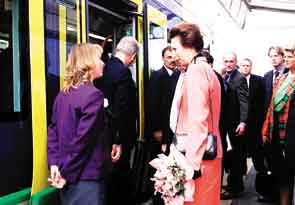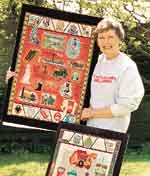![]()
At last - Metro is on right track
|
A massive new business boom for Wolverhampton was predicted as the long-awaited Midland Metro tram got off to a flying start on its maiden trip to Birmingham at the end of May. Wolverhampton's mayor, Peter Bilson said the sleek new system would boost town centre shopping. He said motorists in Birmingham and Bilston could leave their cars in the car parks and let the 145 million tram system take the strain. Within three hours of starting the service the system was struggling to deal with the huge numbers of people wanting to ride on the first day. Metro spokesman, Phil Bateman, said so many people wanted to jump aboard that the trams were struggling to deal with them. Queues built up at several stations as people waited patiently for the chance to get aboard. Councillor Bilson was one of a host of civic dignitaries who packed the tram on its first official journey into Wolverhampton - and it glided to a halt in the town dead on time. Dozens of people gathered at the West Bromwich Central stop when the tram burst through a tape at the launch - and after the trip, Councillor Bilson voted it "a very smooth ride." He pointed out that the Wolverhampton section of the route was particularly interesting because it ran on the road. "It's certainly going to bring a lot of business to Wolverhampton in terms of shoppers," he said, adding that it would also hopefully ease car congestion on the road. Passengers got an early start as they boarded the first fare-paying tram out of the town and many of them carried cameras to record the historic journey. The first to buy a ticket was Philip Elverd, from Upper Road, Meole Brace, Shrewsbury, a member of the Tram and Light Railway Society. "I was the first person to buy a ticket and am really going to enjoy this historic run," he said. But on the first day, as a special concession, the public was allowed to travel on the tram free of charge for six hours. Ten of the 23 stops were in Sandwell and the borough also housed the hub of the system. The depot and offices of the Metro, where 16 trams are based, was in Potters Lane, Wednesbury. It was the first time the trams had returned to the streets of the Midlands for nearly 50 years - and years of planning, months of snags and setbacks, and weeks of dummy runs had preceded the historic launch. The trams were planned to run every ten minutes in both directions initially with the frequency being increased to six minutes later in the year. The key to its success was seen as being the number of people who use the tram in the car-dominated and congested region. The tram fleet took 35 minutes for each end-to-end journey with a top speed of 47mph. They have a passenger capacity of 158 , of which 56 are seated - and the return fare costs 2.40, with tickets being available from machines that give change. Finishing a labour of love . . . In 1999 Sylvia Everitt of Rawnsley put the final stitches into her 30-foot, 11-panel Millennium Tapestry, recording life in her beloved county from 1000 to 2000 AD. "It's taken me tens of thousands of hours and enough stitches to go round the world a couple of times but I've been very lucky with sponsors. "The strange thing is how it moves people. The commonest word in letters is how 'privileged' people feel when they see it. I have taken it around and seen people proposing a vote of thanks with tears running down their face. I don't entirely understand it but it obviously means a great deal. "It begins with the 11th century rape of Staffordshire by the Normans when the whole county was laid waste. It ends with JCB, the Express & Star and a Spitfire." Tale of Wolverhampton's 'one and only serious air raid' On April 27, 1999, things came full circle for a reminder of the most terrible war in history. A piece of casing from a bomb dropped on Wolverhampton was handed back to the town.Former old boy of the Royal Wolverhampton School, Reverend Cannon Dr Brian Murray, regaled the school with the story of the area's "one and only serious air raid" as he presented a piece of wartime shrapnel from the raid to the chairman of the Board of Governors, Dr Donald Huffer, on Founders Day. Cannon Murray, a pupil from 1934 to 1945, recalled the night in the spring of 1941 when houses at the bottom of the school playing field were obliterated by German bombs. The Cannon recalled that he was with his classmates studying "prep" on the fateful night and, as the lads become more and more restless, they would plead to pay a call of nature in the nearby covered yard. "In order to leave our particular room we had to pass through an archway," he went on. "Since this led to the opening of two doors there were two inevitable flashes of light as each 'desperate' boy passed through the tunnel. "My form had always contended that the crew of the stray German bomber dropped the stick of three bombs because they saw the light from the tunnel," the Cannon recalled. "My elder brother, Malcolm Murray, has always held that the bomber aimed at the lights on the school's clock tower, and that they were extinguished immediately after the raid and not lit up again until VE Day." Cannon Murray said the sound that he and the other boys heard overhead was not a British plane, and the result was that houses at the bottom of the school playing fields were obliterated by the bombing." Fortunately no one was home," he went on , adding that his younger brother, Maurice Murray, was in the Junior School at the time - just a few yards from the blast. But Cannon Murray and his classmates dived under their desks at the sound of the bombs. The following day pupils went down to the damaged area to scratch among the debris for souvenirs. "Malcolm and I had to contain our delight when we literally unearthed on the roof of a collapsed garage a piece of shrapnel some 16 inches by four inches," he said, adding that he and his brother managed to hide their prized piece of shrapnel, fearing that some older boy might take it away from them. Later they sneaked it into a case and took it home. Cannon Murray said since then the shrapnel had been shifted from one garage or garden shed to another and was largely forgotten. He said that when Dr Huffer mentioned the memorabilia cupboard he and his brothers decided the shrapnel should go back to the school. The former pupil said he hoped the shrapnel would "evoke many memories of that night long ago when all at the school were in peril of their lives." |
|

 "At
first I worked in oil paints, then I decided to paint with a needle
and thread instead. The idea for the tapestry came in 1994. They
were talking about the millennium on television, which was quite
a rare subject in those days. I thought, why not do a Bayeux Tapestry
for Staffordshire.
"At
first I worked in oil paints, then I decided to paint with a needle
and thread instead. The idea for the tapestry came in 1994. They
were talking about the millennium on television, which was quite
a rare subject in those days. I thought, why not do a Bayeux Tapestry
for Staffordshire.
